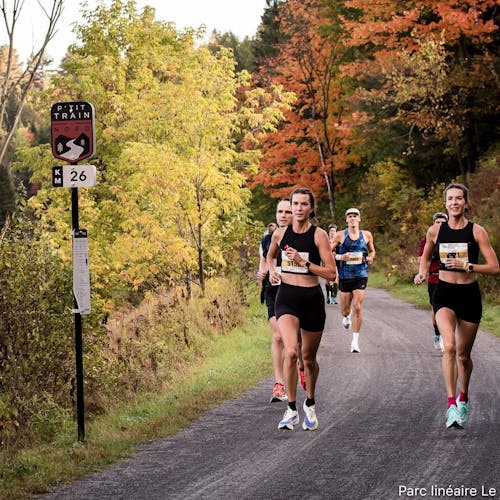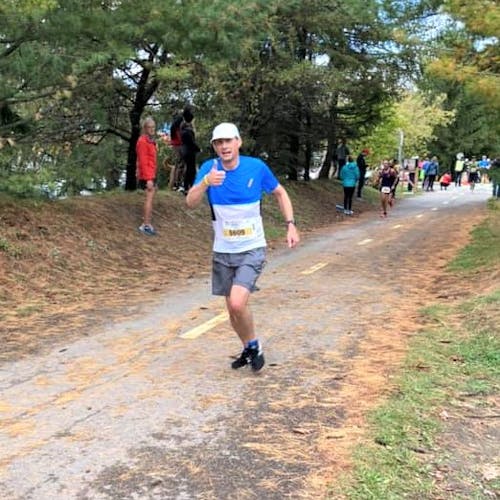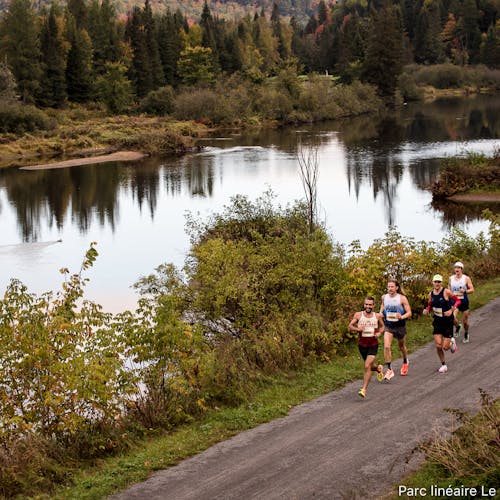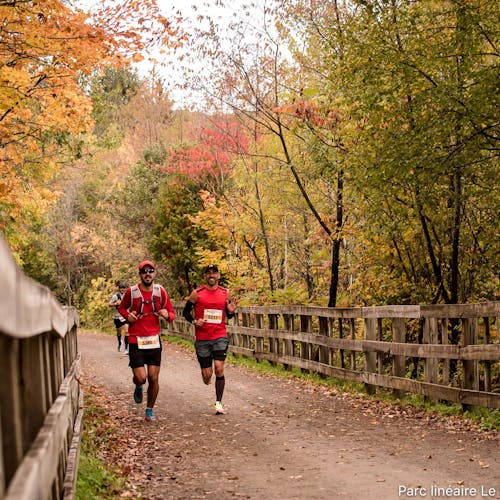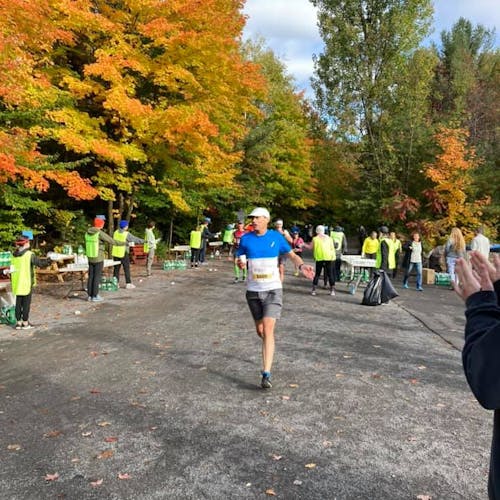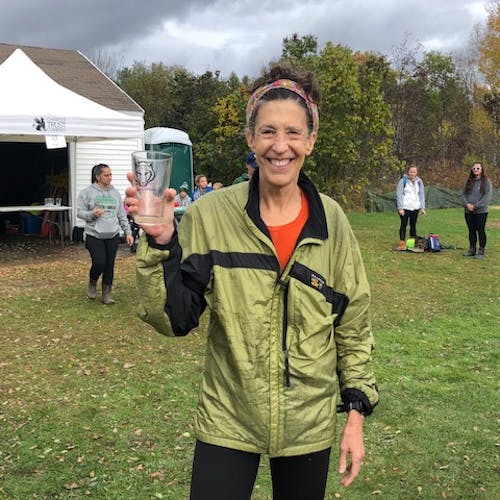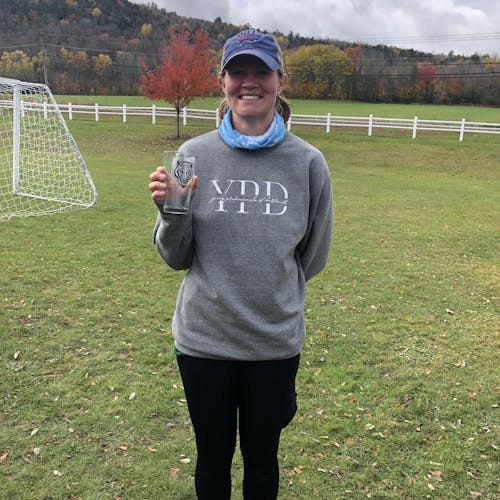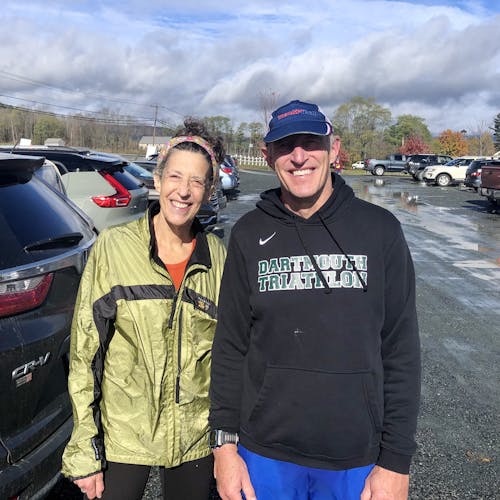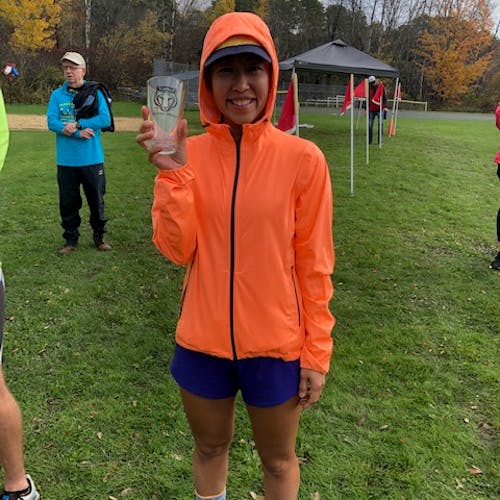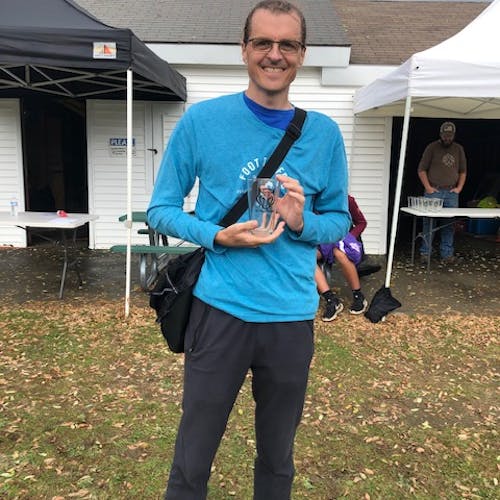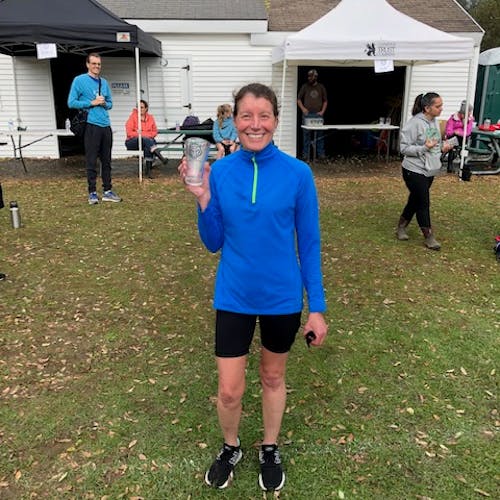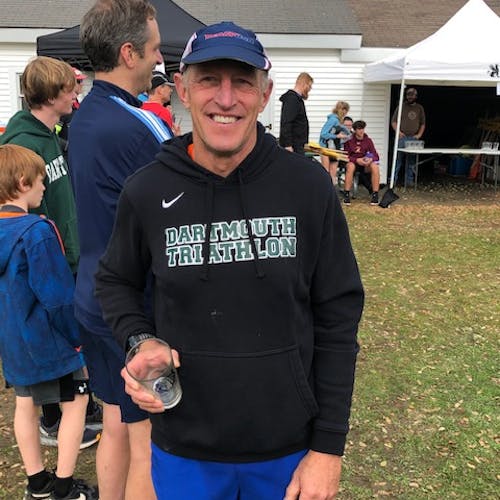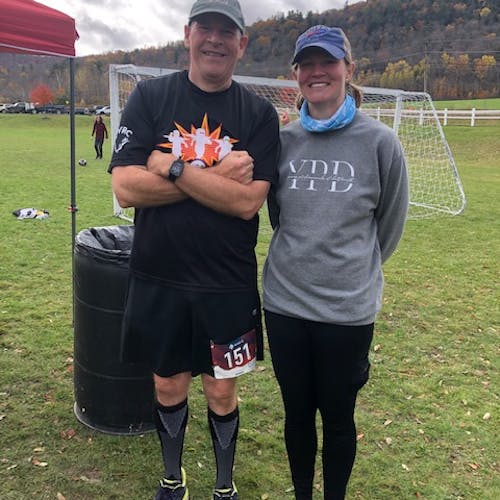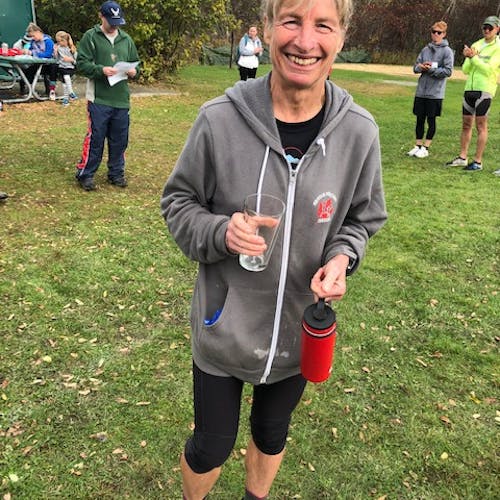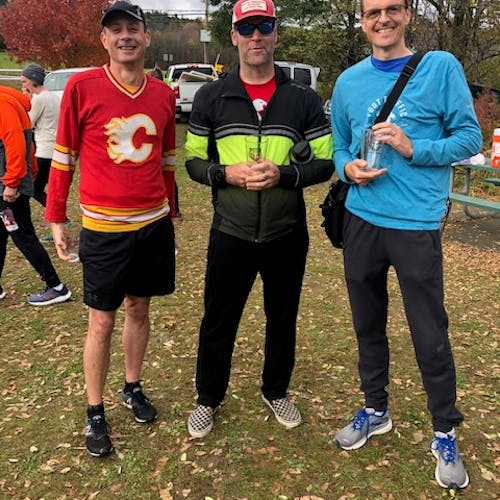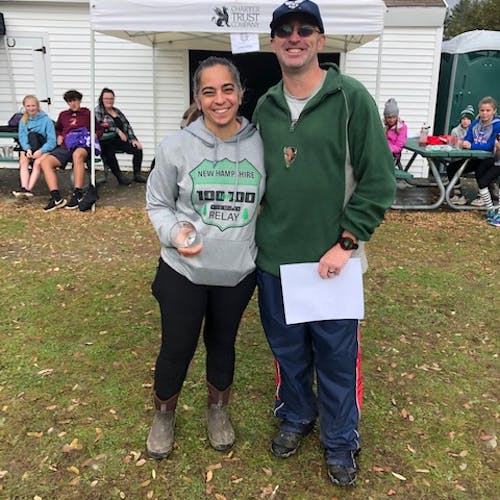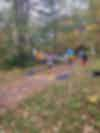November 2021 Newsletter
Editor
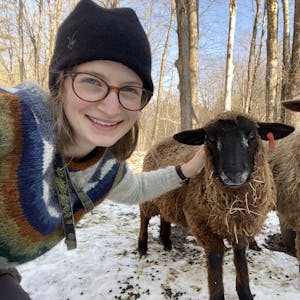
Amanda Kievet
Trail runner, wool mill owner, web developer, quote unquote farmer.
Article Collection
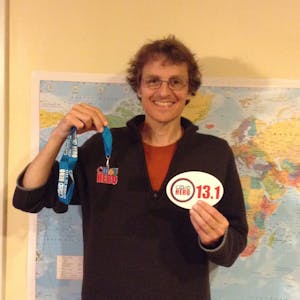
Geoff Dunbar
Former UVRC president, co newsletter editor, and UVRS coordinator.
Table of Contents
- Letter from a Board Member: Happy Halloween and Late Fall, Fellow Runners! by Hannah Taska
- Letter from a Board Member: 2022 Membership Renewal is ready for UVRC! by Krissy Flythe
- TNT Tuesday Night Track / Winter Coaching / Track Marshal / Dartmouth Relay by Tim Smith
- Upper Valley Running Club Singlets! by Krissy Flythe
- Upcoming Races by Geoff Dunbar
- Castle Trail/Israel Ridge Trail Loop by Jennifer Hansen
- Tiger Run Pics by Laurie Reed
- Boston Marathon Report by Madeleine Bothe
- Virtual Boston by Tiff Currier
- Boston Marathon Race Report by Patrick Luckow
- 2021 Boston Marathon by Kyle Dunn
- Chicago for MMRF by Rebecca Stanfield McCown
- The Dartmouth 100 by Joffrey Peters
- VT50 by Hillary Young
- Marathon P'tit Train du Nord by Jim Westrich
Happy Halloween and Late Fall, Fellow Runners!
By: Hannah Taska
While I am not one to philosophize at length or offer a wealth of knowledge on running, I am curious about different people’s running experiences! Having met a number of people recently at club events who are getting into or back to running, or who have just joined the club, I have been curious, for example, how people have motivated through a changing running environment during various parts of the Covid pandemic. Also, I am inspired and impressed in any period by people who start running or pick it up again as adults through their own motivation and work, with or without family role models. In a future article I would like to interview Couch to 5K participants and other beginning and transitioning runners about these sorts of experiences.
For this article, with limited time for interviews, I wanted to think back to what was on my mind earlier in my own running life, so I dug into my late high school/early college running journals.
While I do not remember exactly how I decided to join high school track (my first official running season), I do know that my mom and dad had encouraged my participation in endurance sports through example and family vacations. We hiked most of the 4000-footers in VT and NH when I was growing up, and were lucky to get to do some extensive backpacking in France as well. I kept up my hiking motivation through playing word games and making up stories with my family, as well as looking forward to rock scrambles that would challenge me enough to be exciting rather than simply hard work. I once described the most grueling hikes as “too hard to be relaxing and too easy to be exciting”. Despite my tendency to seek distraction during hikes, over time I did take on a genuine enjoyment of the activity, both as a form of exploration, time in the wilderness, and a way to connect with my parents, brother, and friends. And I went into running and other sports with a fitness base that (I imagine, in retrospect) may have eased the transition into running training.
I also enjoyed the exhilarating feeling of running, as well as the excitement of competitions including running, from a young age, starting in informal contexts. My brother and I would do races and time trials in the swamps and on the roads near our house. I also took pleasure in being in close competition in basketball sprint drills with girls who otherwise had me beat with their ball-handling skills, particularly with those who picked on me (though I had some fear of the possibility they would be annoyed at me for matching up to them in any respect).
A desire to interact with peers in a context appealing to me (particularly since I was homeschooling), and to engage in exciting physical activity, and perhaps also a desire for achievement, motivated a general desire to participate in high school sports. I initially chose soccer and basketball due to my liking of those sports and the participation of a sizable number of girls on those teams (as compared to the few girls who were doing cross-country early in my high school years). I also did track, both out of my own desire and my parents’ love of running and encouragement of me to try out the sport. My mom unfortunately had to forgo running for other sports at a certain point due to joint issues, but my dad was able to continue and remained a consistent summer training companion for me at this time, along with my brother when he was still slow enough for me.
Over the course of high school, a number of factors motivated me to shift to more fitness sports: coordinating scheduling with my brother (my mom was driving us both to sports), my liking of the athletes and coaches in the fitness sports (and experiences with being picked on in other sports), my relatively higher level in running and cross-country skiing capacity for individual achievement, potentially lower risk of the ankle sprains I’d gotten in soccer and basketball, and greater co-ed nature of the fitness sports at my high school.
When I switched from high school to college running, I went from a team of 5 - 10 (at most) women distance runners to around 20, and from near the front of the group to the middle. Mainly this shift was a positive one; I had the camaraderie of more peers, as well as the training and racing company of other fairly competitive athletes. There were, however, some challenges to my ego involved in this shift, particularly in comparing myself to others near my pace. I found it difficult at times when a team-mate of a similar level (especially one with whom I had reasons to be competitive) soared to a greater level of success than I did during a season or perhaps for the rest of our college running seasons. Towards the end of the season we all had reason to be particularly aware of rank, since the top seven, or second seven, or top twelve, could go to certain end-of-season cross-country races. I was often around the cut-off point for these races, and was lucky to get to go to many of them, though sometimes I was less lucky too. At the time I dealt with the competition and periodic jealousy mainly by continuing to train and to appreciate the mutual benefits my team-mates and I gave each other. Also I enjoyed sometimes competing in events frequented by fewer runners such as the steeplechase, or running in conditions which some runners might shy away from.
I experienced changes related to coaching too. While I also liked my high school running coaches, I had particular respect and liking for my college coach, Deb Aitken. She cared a lot about each team member as a person and athlete, as well as about the team as a whole. She thought about our health while also being enthusiastic about competition. I found that she provided a smart balance of easy running with reasonably hard workouts with a basis in science.
Pacing in college races was somewhat different from high school; in early-season cross-country races, Deb would assign us a plan for the first, second, and third miles in terms of who, if anyone, should start off in the lead, whether some or all of us should stick together at certain points, and how fast we should run at different points. High school had been every athlete for themselves in that way I suppose. While such a plan might grate on me now if imposed from the outside, at the time I did not criticize it in my running journal and largely cooperated during races. Given the potential of team members to pull each other along psychologically, such plans probably had some validity.
Fast starts seem to have been standard practice in college cross-country races (both for our coach to assign, at times, and for many other runners to do as well), which was also probably somewhat practical given the large field of runners and sometimes-narrow trail. The pacing which I viewed as ideal was usually closer to steady, though I ended up starting fast often, and sometimes surprising myself with a strong race despite or thanks to the start, and sometimes suffering for the fast start. So my response combined going along with what everyone else was doing because in this case it could actually be helpful, and reacting against that and shifting my pacing in one or more subsequent races because I thought fast starts weren’t physiologically the best choice.
With the frequency of workouts and races at this time in my life, and perhaps other psychological factors, I often expended a lot of effort and/or felt significant fatigue, along with more energetic times, which was not only a challenge in itself physically but also a psychological challenge. Part of the challenge of tough runs for me despite their satisfying aspect was my fear of effort, as well as my fear of giving up and experiencing the shame and blow to self-esteem that would cause. Primarily I managed to push through the effort despite these factors, though there may have been an extent to which I was hesitant to give 110%, such as when a hard race came down to a sprint at the end. Over time, repeated examples of mostly managing to continue despite fatigue dispelled these fears partially, as did improved fitness.
As for injuries, I dealt with shin splints in one or a few seasons in both high school and college, due to some aspect of training transitions, I suspect: shoes? training surfaces? changes in mileage and training types? the impact following hurdling in the steeplechase? I saw a physical therapist in high school and was prescribed orthotics, which I wore sometimes but eventually stopped using, unsure of how helpful they actually were. I also switched to biking periodically when running caused my shins pain. I am as yet unsure what eventually caused the shin splints to subside, whether it was a change in training or footwear or simply general strengthening of the shins and surrounding muscles.
How have I progressed with the above running challenges, and are there morals to the topics above? Those are topics you can take up with me later if you like. I have a few questions for you as well: do any of these experiences resonate with you? Would you like to talk with me about the joys and challenges of your running beginnings or transitions and perhaps be featured in a future article? I hope to hear more about your running adventures soon!
2022 Membership Renewal is ready for UVRC!
By: Krissy Flythe
We are happy that the 2021 year has been a success in the return of more running opportunities and events. We are hopeful for more to come in 2022 and you can do that by starting your new membership for 2022.
Just in case you need a reminder your membership includes:
- Self-starting individuals organizing get togethers (socially), events (races/or other social programs), training opportunities, in addition to our regular slate of events. Club member size is regularly around 250-300 members. That is runners of all ages, shapes, sizes, strides, speed, and more. Your virtual connection to many runners in the Upper Valley via a group e-mail all@uppervalleyrunningclub.org. We do ask that you keep items specific to the club’s mission above.
- Weekly challenges with Tuesday Night Track (TNT), and Saturday morning runs.
- A monthly newsletter featuring articles written by club members and board members. If you would you like to share an article you can visit here for newsletter article guidelines and then send an e-mail to newsletter@uppervalleyrunningclub.org and Follow UVRC on social media platforms: Website, Facebook, Meetup, Strava, Instagram. Refer a friend to sign up here: www.LebanonNH.gov/register
- Club Competition at its finest! We compete against other running clubs in NH. Some events include the Mount Washington Road Race, the Upper Valley Running Series, and the NH Grand Prix.
- Limited edition UVRC Logo masks are available and if you would like one or want more we have them. Below Jim (Club President) is wearing a Large face mask in both styles. The fit is snug and the ear loops are medium stretchy and durable. The mask stays in place and doesn’t slide off your nose = nice! There are no returns for obvious reasons.
In stock:
o 11 XL - Black mask with white outline
o 20 L - Black mask with white outline
o 8 S - Black mask with white outline
o 16 XL - White mask with black outline
o 25 L - White mask with black outline
o 9 S - White mask with black outline
o 4 L - Black mask with black outline
- Access to training, coaches, and a running community that can HELP answer your questions. Visit: https://uppervalleyrunningclub.org/we-need-more-questions
- Omer & Bob’s here in Lebanon, NH, has been a strong supporter of the club since its beginning. They also provide members with a 15% off shoe & other running related gear discount.
We look forward to having you be part of the UVRC and do encourage if you are interested in joining a committee whether it is the social committee, volunteering, newsletter, UVRC gear, training, or race involvement you can always e-mail myself Kristine at Kristine.flythe@lebanonnh.gov or contact@uppervalleyrunningclub.org. Be well, be safe, and keep moving!
TNT Tuesday Night Track / Winter Coaching / Track Marshal / Dartmouth Relay
By: Tim Smith
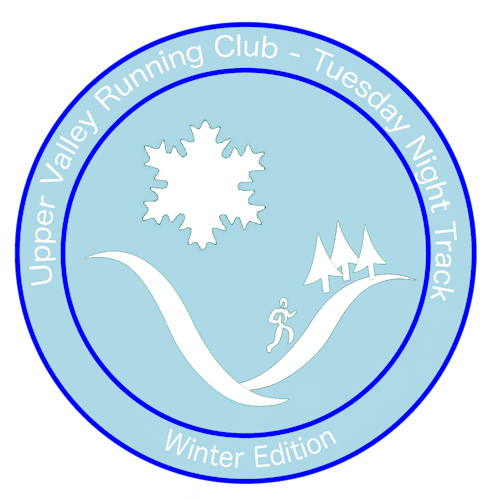
It has been a delight running TNT on a lot of grass this last month, but "The Times They Are a-Changin'" (Bob Dylan) or maybe "To every thing there is a season" (various sources) and in November we will be transitioning to Winter Track.
Occum Pond / Daylight Savings
Our workouts have been pushing into the twilight, so even before the daylight savings transitions, we will be at Occum Pond, starting Tuesday, November 2.
We meet at the parking area near the DOC house and sledding hill. It is almost exactly a mile on the road around the pond (to within about a dozen meters). We meet here in the winter because:
o The tracks are often covered with ice and snow.
o There are street lights all the way around the loop.
o It gets plowed.
o There is little traffic.
o You can always turn left and never cross traffic.
What to wear?
Often I arrive with an extra layer, and then strip it off after a lap or two. During the middle of a hard work-out, the fence next to where we start can be covered with discarded jackets, shells, gloves and other layers.
Be Visible
Don't forget to wear some sort of reflector and/or head lamp. Traffic is low, but it is not zero, and we are often running in the middle of the road.
Workouts
After Thanksgiving we will switch over to "Winter Mode", which means less intense. In the winter we tend towards longer intervals and less speed. It is several months until your next major race, so it is a good time to let your body relax a bit. Still, a weekly burst is a good thing for the legs and lungs. We have a monthly cycle of workouts through the winter:
Week 1: Long intervals. The most common thing would be repeat miles.
Week 2: A two mile time trial (traditionally "Pub Night").
Week 3: Hills - for this we meet at the bottom of Tuck Drive Hill, by the Ledyard Bridge.
Week 4: Tempo Runs.
Week 5: (Nov 30 & March 29) We don't have many 5th weeks this year. I'll try to figure out something unique.
Winter Coaching
I am looking for someone to step into and help with the coaching this winter. I have been doing this almost every week since pre-covid, and I am looking for someone who can promise to show up at TNT and launch the workout.
If you can do this - even if it is only some of the time - please email me.
Track Marshall
One of my new things this year is that I have volunteered to be the head marshal for the Dartmouth home track meets. A marshal's main job is keeping spectators off the track during races. But the best thing about being a marshal is that it gives you a legitimate reason to be in the best position to see the meet. (yes - and you get in for free!).
The home meets are December 11 (probably Vermont, UNH, Maine) and Jan 8 & 9, (The Dartmouth Relays). If you are interested, or have more questions, please email me.
Dartmouth Relays
I've just been talking with one of the assistant coaches who is working on organizing the Dartmouth Relays. Because of Covid, the exact nature of the relays has not been determined. However, right now they are planning on a masters or open mile (or 1500?). There is also a chance that we may be able to get into other events! I think I remember hearing interest in a 800m, or a 3000m. Keep your ears open.
Conclusion
Winter is a time when I think about cross-training, (which for me is cross-country skiing) and recovery. But it is not a time to give up on your body. It is just a time to change how we do it.
Upper Valley Running Club Singlets!
By: Krissy Flythe
Do you want to represent UVRC in style? We’ve got UVRC singlets for sale and we would be happy if you’d like to purchase one you can do so right online! Inventory numbers are below! Please note that we will review orders daily and will treat it as first come first serve. If we find we’ve over sold because our “tech” isn’t as fancy as it’s showing we will make sure to refund you.
The UVRC singlet in use!
Upcoming Races
By: Geoff Dunbar
A couple of UVRC members passed along some races coming up that might be of interest.
First, Ellen Chandler told about the “Go Glo 5K Run and 1- Mile Fun Run & Walk”. This race is run at dusk, on November 6 in Grantham, NH.
https://www.runreg.com/eastmangoglo5k
Next, Ellie Ferguson sent information about a winter series, the “N.H. Snow or No, We Go Series”. Taking place from January through March, 2022 in various New Hampshire locations. These trail races are run whether there is snow or not; it’s up to you to figure out trail shoes, snowshoes, microspikes, etc.
Castle Trail/Israel Ridge Trail Loop
By: Jennifer Hansen
Route: Castle Trail/Israel Ridge Trail Loop, Mt. Jefferson, Randolph NH
Percentage Runnable: 25-30%
Distance: just under 10 miles
Elevation: change: 4,400'
Parking: Castle Trailhead, 1095 Presidential Hwy, Randolph, NH 03593, 93 miles, 1:53 from Lebanon
If you've been reading my column for a few months, you've probably noticed that I think the best trail runs involve some hiking. Or, maybe the best hikes involve some trail running.
This loop over Mt Jefferson is the latter. If I may add that the best hikes/runs involve some rock scrambles, this one has it all!
I read about the Castellated Ridge, which Mt Jefferson flings out to the northwest, in the White Mountain guidebook. I had hiked Jefferson via the Caps Ridge Trail several times; it's known for starting at the highest trailhead of any White Mountain 4000-footer, and therefore is a quicker way to bag an over-5000-foot peak than many routes. Now in search of more interesting ways to go up, I read about the Castle Trail, which is described in the Guide as providing "magnificent views in a spectacular setting," and "rough, with some difficult rock scrambles."
The first and last 1.5 or so miles of the route are comfortably runnable, and the rest of the loop involves rock scrambles and steep climbing up Jefferson, then a steep descent into Edmands Col before taking the more gradual and often runnable Israel Ridge Trail back down to the junction with the Castle Trail.
The key to me is not to become a statistic. I would only recommend doing this route as a runner (which means moving fast and light) on a day that is sure to be pleasant - zero chance of rain and temps such that I can pack light. On a colder day, I would wear tights and pack a windbreaker, but I would not go on a day when I needed more than that, and certainly not when there's any chance of snow or ice. My trip was in mid-September. At other times of year, I would pack much more gear and make it a hike.
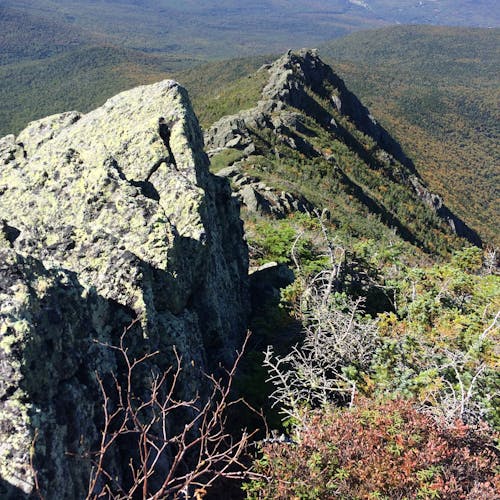
Looking back along the trail after several scrambles
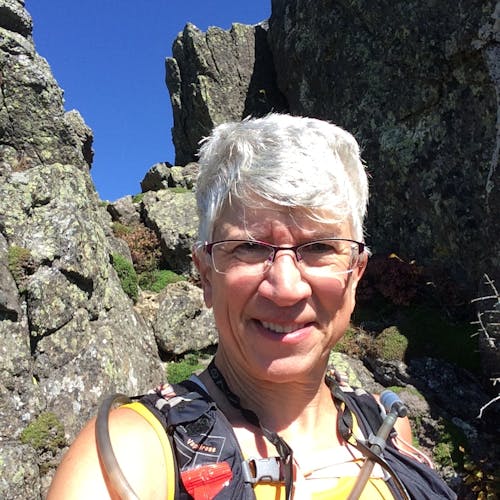
Standing under a "castle"
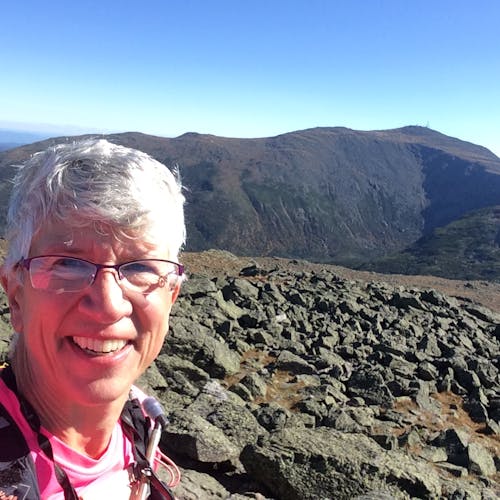
View of Washington from Jefferson summit
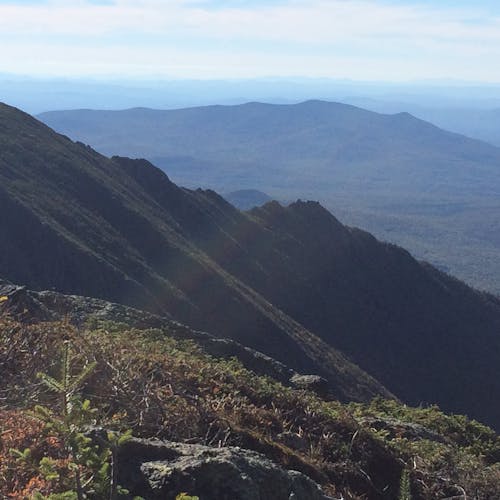
Castle Trail viewed from Israel Ridge Trail
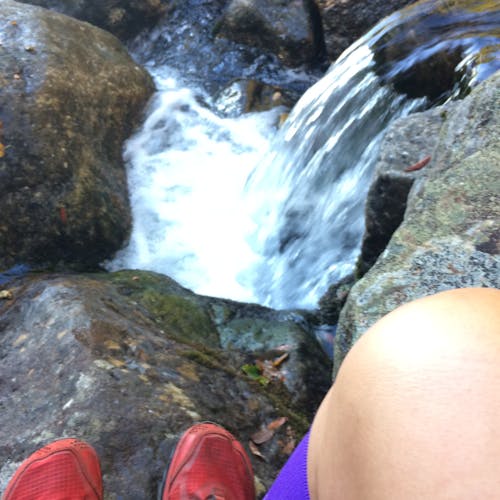
Plenty of water on Israel Ridge trail; bring your filter

At the end of the day, looking back up to the castellated ridge
Boston Marathon Report
By: Madeleine Bothe
What’s blue and yellow and 26.2 miles? Yep, that’s right, the Boston Marathon!
I found out last spring that the Boston Marathon was taking place in October for 2021 instead of the traditional Patriot’s Day in April (due to Covid). The timing of this race was perfect for me not only because I wouldn’t have to train through the winter which isn’t impossible but would have been hard for me; but I was looking for an anniversary run since October 2020 was a time of tremendous grief for me when I found out that I would lose my son Oliver at 22 weeks pregnant. I wanted to run in his honor the following year and since Boston Children’s Hospital was an important part of my pregnancy, it felt right to raise money for them throughout my training for the marathon. It was also an opportunity for me to run this iconic marathon without having to qualify which isn’t something I have ever trained for.
I have run one marathon before in what feels like a previous life when I lived in the UK and hoping over to Paris was as easy as getting on a train for the weekend. It was a spring marathon and although I had a fun experience, I didn’t think it was a distance I ever needed to run again. However, running, as most of you can sympathize with, is a tool for overcoming stress, grief, and just about anything negative. Have a crappy day? Go run and you’ll usually feel better. I realize that I’m preaching to the choir here.
I grieved hard and took it out on the trails, roads, and miles. It makes the grief manageable most days.
Okay, more about the race which I know a number of you have done before.
- It’s enormous….especially after being in Vermont seclusion for the last year or so of Covid. I underestimated the size of this thing and there were some seriously fit people there. Plus Boston gets all dressed up for this event which was just awesome.
- If I thought that Facebook group for runners was competitive, the atmosphere around the Marathon expo and the bus loading to Hopkinton was thick with competition. Everyone was super friendly but marathon runners have their rituals and mindsets (keep in mind I’m more of a trail and Upper Valley Running Series kind of gal).
- There were 7,500 volunteers and just over 15,000 runners on race day. That’s almost 2 runners to every volunteer who were extraordinarily nice…like super nice. There were also thousands of police and security which made me feel incredibly safe…?
- I had an amazing fan club who came to cheer me on and I saw them all around mile 24 (ish). I got the impression from all the fans, including mine that watching this race is just as emotional as running it. Again, I’m not a regular marathon runner but it seemed like this was another special Boston Marathon thing like the Wellesley girls (who are also amazing)!
- The wide open four-lane roads of the course are just as challenging as the 4 “hills” between miles 16-21. I underestimated that after a summer of running on many narrow dirt roads. Heartbreak Hill is nothing compared to the hills we all run around here but at mile 20, it hurts and the downhill after that is only fun because of the cheering and not because it’s downhill.
Boston Children’s Hospital raised $2.2 million from the 125th Boston Marathon and I’m really proud that some of you contributed to that effort through my fundraising. I’m so incredibly thankful for this opportunity and for you!
Virtual Boston
By: Tiff Currier
Back in March when I heard that the Boston Marathon was going virtual, I decided this was most likely the only way I was ever going to be able to participate in this race and signed up. I am not a fast runner so I knew I would never be able to qualify, but I wanted to be a part of the Boston Marathon. Over the months leading up to the virtual race in October I asked myself many times do I really get to say I ran the Boston Marathon? I didn’t speak much about running the virtual Boston Marathon because in my heart I wasn’t running from Hopkinton to Boston and up Heartbreak Hill among many other landmarks along the way.
Over the months my husband kept telling me this race in some ways is going to be harder than running up Heartbreak Hill because on the course for the marathon there are thousands of people supporting you along the way. When you run, you are not going to have anyone to chase down no fans cheering you on other then what family is going to come out. I didn’t really believe him and thought he is just saying this to make me feel better about my run, but boy was he right (just don’t tell him I said that LOL).
On Saturday October 9th my mom and crew dropped me off at Andover Potter Place Depot at the rail trail to start my journey. My support crew consisted of my husband and my mom. I had a friend and my son Gunner taking turns running with me so I was not alone in case I ran into trouble, but looking down the rail trail with no one in the distance to chase down there was a feeling of emptiness and being so alone. I know I had someone with me the entire way but they were switching out so I knew I was the only one running the entire 26.2 miles. My mom and husband were a huge part in making sure I had everything I needed and finding side roads to see me along the way, it really kept my spirits up knowing they were not far ahead waiting to cheer me on.
With each transition of runners with me, the closer I knew I was getting to my goal. That is when the mental game starts with any marathon that you do and you start to question yourself. Can I really finish this race, did I prepare enough and most of all what the heck was I thinking when I signed up for this? My last transition was in Canaan NH on Depot Street, at mile 20.6, and my son Gunner was going to finish the reminder of the race with me. I also knew at this point my race crew was heading to my finish line and would not see them again until then.
That last 5.6 miles seemed like it took as long as the previous 20 miles had, but having Gunner with me telling me about different landmarks that were coming up and how far till the next landmark was huge for me. He was more than just someone making sure I was ok or to call for help if I needed it, he was my encouragement for those last very long miles. As I got to Blackwater Road across from Mascoma Valley Regional High School he let me know I had just about 1 mile to go. I knew my husband and mother were going to be up the trail waiting for me to come in but I didn’t know the surprise that he had planned for me. As I approached the 2021 Boston Finish line he created for me, along with balloons and a finisher tape to break provided by Lori Bliss Hill and her daughters Baylee and Trinity (who were also there to cheer me on), the tears began to run down my face. This was the moment I realized just because I didn’t start in Hopkinton and finish in Boston doesn’t mean I didn’t run the Boston Marathon; I ran my Boston Marathon my way in my time.
In all honesty I cannot imagine running my Boston Marathon any other way. From the perfect weather, to the beautiful leaves changing, the company and support I had along the way it was absolutely amazing and perfect. This day would have never been able to happen if I did not have the full support of my husband and family who gave up countless hours with me so I could put in the miles needed to reach my goal. So to them thank you for helping me make my dream of running this race come true.
Boston Marathon Race Report
By: Patrick Luckow
Photo Credit Paul Nelson
I didn’t know what to expect going into the race. Everyone kept asking me how I felt and I just shrugged. I had a great half marathon in Charlotte VT in September, and successfully upped my mileage a bit from previous training cycles. But I had struggled to hit splits in my workouts, and long runs had been slower .I joined a local group run for my shakeout. I felt fine, dialed in and ready to go, and finished on Boylston street, staring down the finish line with a smile. Boston was back.
Monday morning I took the T to the Boston Common to meet some friends and take the bus to Hopkinton. We arrived at the start, fiddled around for a few, and off we went with a shrug. Boston 2021 was a rolling start; it felt odd to just go, without the standard standing around in a crowd of thousands of our closest friends.
The first 10 miles flew by. It was a nice steady but fast pace that felt comfortable in a way unique to a marathon you’ve built up to over many months. I told my friend Matt I was going to dial it back a touch. He agreed that was probably prudent, and asked me to lead. Of course a few minutes later he took the lead again and I sat on his heels, unwilling to let him get away, even if it was a little faster than I wanted. Around this time I had my first Upper Valley sighting, as we passed my training buddy Kyle who was going at a smarter, slightly steadier pace. Shortly thereafter I veered across the road to high five my wife Cindy, who had made her way to Natick to cheer for me. This was pretty fun!
Around mile 11 we caught and passed Shalane Flanagan, who was having a quick chat with her pacer, immune to the cheers of support from the crowds. A little before the halfway point we went through the Wellesley Scream Tunnel. I had ignored this feature the first time I ran Boston in 2019, sticking to the middle of the road, but this year I caved to the peer pressure of a friend in front of me and high fived as many of the screaming ladies as I could. Up another hill, and as things were starting to get uncomfortable I had my second Upper Valley sighting, Kyle and Sara cheering on the right side of the road. I veered across for more high fives and a little boost of speed. As we went through the half the big sign said something like 1:20, which meant the pace was looking pretty good.
The Newton Hills were next, and as my pace slowed I feared this could be a breaking point. Over the highway, and a right on Comm Ave past the firehouse. Just get to the Somerville Road Runners cheer zone at 30K and look decent when you pass all your friends there, I told myself. We kept cruising, my friend Matt and I arriving together. The noise of the cheers gave me another boost of speed, high fives all around as I took a feed. Not particularly hungry, but I gulped down the maple syrup, hoping for a boost. Heartbreak Hill was hard, but I felt steadier than in 2019. Maybe all those Upper Valley hills are good for something! A giant cheer from my physical therapist, small child on her shoulders, gave me the boost I needed to get up and over. All downhill from here, sort of.
I was really hurting, but the noise was getting louder, almost deafening. I heard cheers for Shalane and understood. I held her off for a minute or two, feeding off the noise, until she passed me never to be seen again. Down into the city, things really hurt, but I just kept putting one foot in front of the other, not looking at my watch. It turns out my pace wasn’t quite as slow as it felt; a testament to all the base miles over the summer. Before I knew it I was taking a right onto Hereford, gritting out the last stretch. Cindy was somewhere in the deafening crowd and later remarked that I looked worse than I ever had at the end of the race. Left onto Boylston. I knew this stretch was deceptively long and I was ready for it. I emptied the tank to finish strong, knowing I could collapse after the finish and be done. Before I knew it I was crossing the line.
My time of 2:40 was a touch slower than the last time I ran the race, but close enough to be happy with, and my overall placing a little higher. But I had forgotten just how amazing of a race Boston is. What feels like the whole state is out there cheering for you, and it was great to be back.
2021 Boston Marathon
By: Kyle Dunn
I went into the Boston Marathon with a wide range of expectations. I took a break from running after having my first child and with limited marathon experience it's hard to even know what my pace should be. Going into the race, especially without race support and help navigating pre-race logistics due to the pandemic, I decided I would be happy with anything from a new PR (about 2:50) to anything around 3 hours where I wouldn't have a sad ride home from Boston. Without the Athlete's Village I wasn't sure how pre-race fueling and warm-up would go.
Before the race I ran into an old friend from college by the city of porta potties and we had a similar goal (2:50), so we went to the rolling start together. Originally I was expecting and planning to go out a little hard on the downhill in the first few miles. He had a much more conservative plan, so we started off with a relaxed pace, slower than the goal marathon pace. I had a Patrick Luckow sighting in the first few miles as he cruised down the hills past me looking very strong at the start! The conservative strategy worked well and I felt good going into the middle chunk of the race before the hills, although I wondered if we were a little too conservative.
In Framingham we started to cruise closer to our goal pace of 6:30 min/mile. Heading through Wellseley felt great and I started to really use the crowd support as I picked up the pace heading into Newton. The hills were definitely noticeable at a higher pace, but I rolled back expectations a little through the Newton hills knowing that the Upper Valley got me ready for them. Finally the hills were done and it was mostly downhill with great crowds heading to the finish.
I opened up my stride and finished below 6:30 pace, as planned from the start. The crowd support for the last 10k leading into the city was phenomenal and definitely helped get me through to the finish! The final push down Boylston St is always longer than I expect it to be, but you kind of want it to last with the crowds lining the streets. Somehow I even heard Chris Welker cheer through all the noise! I pushed to sub-6 pace for the finish and had so much fun going for negative splits towards the end. A few friends from the Boston area greeted me at the finish with some chocolate milk. I finished in 2:50:49, missing my original goal, but I had so much fun with the fast finish without bonking that I was very happy with the race.
All in all, it was a good day. If you don't hit the wall in a marathon, you may always wonder if you could have gone just a little bit faster. It was definitely challenging navigating the pandemic and getting over my anxiety of being around so many people for the first time in years. The crowds always amaze me and this year they were a little terrifying too. I will definitely run the Boston Marathon again and be shocked by how many people show up to cheer.
Chicago for MMRF
By: Rebecca Stanfield McCown
On October 10th, I ran the Chicago Marathon with the Multiple Myeloma Research Foundation’s Team for a Cure. When my husband, Chris, was diagnosed with multiple myeloma last October, I knew right away I wanted to be able to support the important work of finding a cure. I had run the New York City Marathon for Grassroots Soccer and Chris and I had already raised almost $10,000 for the MMRF when we first shared his diagnoses. It seemed natural to combine running with raising money so I signed up to join the MMRF’s charity team as soon as I could.
I followed a strict “no training training plan” through the summer. A low stress way to ensure weekly mileage stayed up and I did whatever long run the rest of my running friends had on their schedules. Thankfully, there were about 5 of us training for either a marathon or an ultra so there were plenty of long runs to jump in on. I went into race day with about 3 weeks of very little running due to a shin injury. I decided to postpone an MRI because nothing was going to stop me from running Chicago. And luckily for me, race day magic meant my shin didn’t hurt. But that is where race day magic stopped!
The race itself was challenging but as I was struggling on the course. It was a humid and windy day in Chicago and by mile 18 I was pretty much tapped. I was nauseous and gusts of wind kept making me feel like I was going to be blown over sideways. Between miles 10 and 25 I did what felt like a ton of walking and sluggish running. I was in the dreaded part of marathon running where you are watching all your time goals run past you, literally watching the pacers for my A goal and B goal run past me. I managed to finish with a new personal best and a BQ. I wish I could say I was satisfied, however I thought I could do better.
But while I was out there struggling, I thought about my charity teammates that were also out there running and the dozens of people that had supported me through their generous donations. I thought about my husband at home, just shy of 100 days post stem cell transplant, cheering me on. It was because of all these people that I was able to cross the finish line with a smile. My time doesn’t matter, I raised almost $5000 for the MMRF and helped get us one step closer to a cure.
The Dartmouth 100
By: Joffrey Peters
This is not about a sanctioned Dartmouth 100-mile event, and indeed it has nothing really to do with the school. This is about my own journey to run the Dartmouth 50 route out and back, beginning and ending at the DOC on campus, following the Appalachian Trail, and turning around at the Ravine lodge.
When I moved to the Upper Valley 5 years ago, I wasn’t really a runner. I had done some big runs in the mountains - mostly hiking - but I didn’t run regularly or identify as a runner. When I began running more regularly, moving quickly through the mountains was still my inspiration, and running served as a means to that end. It is perhaps a surprise then that it was things like UVRC’s Tuesday Night Track that drew me in and helped shape me as a regular runner. A “real runner” - or at least, someone who identifies as a runner. But the community kept me coming back, and as I learned, speed builds efficiency, and that’s what I would need to travel long distances in the mountains.
The 100 mile distance is daunting, and the more experience I got going long in the mountains, the more respect I gained for it. It is a very long way. When I finally committed to trying it, I wanted the experience to be mine and to learn from it and grow from it as much as possible. So I selected something rather difficult: The Dartmouth 50 course as an out-and-back… but all by myself, without support or stashed food or supplies, filtering water and bringing everything else I might need from start to finish. The route is 102 miles with 30,000 ft of elevation gain. That’s a lot, even by big mountain ultramarathon standards. This was a Big Scary Goal, but it excited me!
In all, things went about as well as one can hope for. During a 36-hour run, a lot can go wrong! After the first few miles, I settled into a maintainable effort, and was moving and eating fairly well. The terrain is steep and footing seldom smooth. Even those sections which are “runnable”, I took quite easy, seldom surging past a trot, knowing I had a long way to go. This is the great part about ultra-distance runs: There often really isn’t that much running! I hiked mostly, and trotted or jogged the downhills and precious few flats. Stopping for water and clothing shifts, etc, basically ate up any speed advantage from running and my net pace was that of a hike.
There is probably a better time of year to do this kind of thing, but as it worked out, I finished on my birthday, and the day before my son’s birthday. Perhaps not particularly poetic, but it added to the meaning of the trip for me, and gave a good excuse to eat a lot of birthday cake!
Earlier in the year, I ran hard half-marathon, 5k, and track mile races and time trials. Very little about running 100 miles in the mountains feels like those events. At no point did I ever push hard during the Dartmouth 100. There was never the burn of legs and lungs. Any wind was the weather, not my own pace. The slow grind of it certainly wore on me, but I tried to smile at least once each mile. Smiling makes me feel better, even when I’m hurting, and it improves running economy.
Going out on trails to travel 100 miles under my own power is a preposterous and privileged thing to do, and I tried to appreciate it. At one point, in the rain about 40 miles in, I was sulking and thinking about quitting. Two south-bound AT through-hikers passed me, smiling with cheery greetings. These folks have to put up with this stuff for weeks. Getting wet might mean a wet sleeping bag for days, or at least wet shoes and clothes for a while. And they are smiling! There was nothing to do but put on my rain jacket, try to smile, and keep going.
Some highlights of the trip include: seeing nobody on the summit of Mt. Moosilauke twice (really, in the clouds, I saw almost nothing at all up there), some really gorgeous leaves both on trees and on the ground, ridiculous hills covered in acorn ball bearings, an apple tree leaning over the trail, from which I snagged two delicious apples, and the encouraging words I occasionally received via text message on peaks with cell service. Several times on route, I thought about how I often don’t hike Mt. Moosilauke because it feels far away, yet here I was running there and back!
It was a great adventure, and I had huge support from my wife letting me get out for two days while she was a solo parent, and from the trail running community who keep me company training, and help inspire me to silly, big ideas like this. Running has as many meanings and purposes as participants. Each of us can define our own goals and dreams. But make some of them big, and a little scary.
A trip report with gear lists and too many details is on fastestknowntime.
VT50
By: Hillary Young
"The weather was perfect for fall running..."
I ran my first 50k in 2019. I ran two actually and made all the rookie mistakes. I went out too fast and blew up. Well, at least my stomach contents did on the grass just past the finish line and inches away from my husband’s Birkenstocks. I chafed in places I did not know could rub. I tried new things on race day! Despite all my mistakes I was pumped to do better the next time. But next time would have to wait until the Vermont 50k in 2021. Thanks for nothing COVID.
"I get to the race early so I can go through the ritual of organizing my running packs."
I lined up on September 26 feeling confident. My training felt solid. The weather was perfect for fall running, meaning it was not pouring rain or 90 with 100% humidity like all my long runs! I get to the race early so I can go through the ritual of organizing my running packs. In the end, I leave half of my nutrition behind and gamble that I can eat things from the aid stations. At the starting line, I am able to find my friend Charlie. We did some of our training runs together over the summer. We start out running together and fall into a familiar rhythm. My plan was to run my own race at my own pace even if that means running alone. But, that went out the window at the first hill. The new plan quickly became “do my best to keep up with Charlie.”
"The new plan quickly became, 'Do my best to keep up with Charlie.'”
The first 17 miles ticked off fairly quickly. I was quick in and out of aid stations and chatting made the time pass by. At mile 17 I started doing creative math. I had myself convinced I PR’d my road half marathon time (not true), that I was on sub-6-hour pace (also not true), and that I only had 10 miles left (unfortunately also not true). My back tightened up and my stomach cramped. My legs got tired but fortunately were okay otherwise. The conversation became sparse after mile 25. It took all my energy just to keep shuffling forward trying my best not to lose my friend.
Somehow I managed to hang onto Charlie the entire race. I kicked up the pace when we hit the Ascutney biking trail switchbacks. Downhills are my jam. Charlie tried to get me to go ahead of her so I could open it up down to the finish. But no way was I going to pass her after she pulled me the last 14 miles of the race. We crossed the finish line together just like we started. In the end, I managed a 30-minute course PR, and I am already planning how to do better next time.
"We crossed the finish line together just like we started."
The Vermont 50 is definitely a race to check out. For runners, there are options to do a 50k, 50-miler, or 50-mile relay. Mountain bikers only do the 50-mile version. This year all the races sold out. Mike Silverman is the race director and runs a tight ship. The course starts out at the old Mount Ascutney ski resort and winds through the hills of Windsor before looping back to the start. It’s a mix of dirt roads, snowmobile trails, and a single track through some beautiful scenery. Registration opens up in May each year. Maybe I will see you there next year?
Marathon P'tit Train du Nord
By: Jim Westrich
This year the Marathon P'tit Train du Nord in St. Jerome, QC in the Laurentians held its fourth edition on October 3rd. I had planned to run this marathon in 2020 but after it was cancelled I decided to roll over my entry. Because of the uncertainties of the event and restrictions on crossing the border from the US I was one of the few US runners in the race with over 2000 finishers. I am glad I made the effort (in many ways).
If anyone is considering various fall marathons I highly recommend Marathon P'tit Train du Nord. It is a beautiful, flat, and fairly relaxing run entirely on the P'Tit Train du Nord railtrail (which itself is part of a larger network of bike/run friendly routes in southern Quebec known as La Route Verte). The race used to be held a few weeks later in October so the colors were nice but a little post peak—this year there were lots of beautiful colors but it was a bit pre peak. I think the pictures will speak for themselves on how pretty the route is.
The route is also very flat with a little net elevation loss. The beginning of the race is in Val David, a quaint ski town and it is a point-to-point course to St. Jerome. You can see a lot of hills early in the race but you do not have to run up any of them (!)—the start line even has a very steep little hill right next to it. There is a few miles of pavement at the start and end but it is mostly very packed crushed gravel. The course is designed to be relaxing and easy so you can enjoy what you want of the scenery. The water stations were every 4k or so and had plenty of water and sports drinks available. I had no medical needs but saw plenty of medical people on bicycles ready to assist (I heard from family that there was a golf cart that transported a runner who needed more serious attention). There were around 2500 hundred runners and we had a staggered start of 200 people every 2 minutes. There was also a last minute set of Port-a-Potties right next to the start line which I think every race should emulate.
For me it was definitely the least dramatic of any marathons I have run (this was my 4th). There were always people around to make pacing easier and racing more enjoyable without anyone getting in the way. There were maybe a thousand spectators at the start and finish but generally the race did not have a lot of cheering crowds. One unexpected touch was that a lot of the people on the course took the time to read the name on the bib and cheer for you personally. I guess in Quebec Jim is an uncommon enough name that a lot of people changed it to "Jimbo"—getting cheered on as "Jimbo" made me smile several times.
The flat course let me try to keep a steady pace. It was going pretty well but then around mile 10 I started to get wildly varying pace readings on my watch. I am not sure what was happening (it is certainly possible that there were some GPS issues running through valleys the whole way) but seeing some paces 2 minutes slower than I wanted got me to speed up (I ran a too fast 11th mile). I then got wildly fluctuating readings for another 2 miles and eventually whatever the problem was sorted itself out. There really was no other drama. I ran, I got tired, I thought about writing a children's book for runners called "Oh, the Lactic Acid You Will Know", and then I happily finished.
My goal for the race was to qualify for Boston 2022 and around mile 20 it was clear that as long as I did not totally fall apart I could meet my goal. Not completely confident I could keep at the pace I was at all the way to the end, I did slow/tire a bit over the last 3 miles but qualified easily for Boston (3:25:17).
We capped off the day by going to the Findlandais Spa in Rosemere and drinking Le Castor beer. An even more relaxing finish to my fairly relaxing marathon weekend.
